
Tatsuya Tanaka
Waseda University
Mechanical Engineering
Status: B4 Expected Graduation: March 2017
Research Host Lab: Tezduyar Lab, Mechanical Engineering, Rice University
![]() Research Project Poster: “Fluid and Structural Mechanics Analysis of the Orion Spacecraft Drogue Parachute in Compressible-Flow Regime”
Research Project Poster: “Fluid and Structural Mechanics Analysis of the Orion Spacecraft Drogue Parachute in Compressible-Flow Regime”
Why Nakatani RIES?
The Nakatani RIES Fellowship stands out for me because it provides opportunities not only to improve my English skills, but also to experience practical research activities in Rice University and to learn to decrease miscommunication and be able to understand each other. Language skills are not enough to communicate with people from other countries in the real word. When I was working for a local travel agency in India as an intern, I faced a lot of cultural differences between Japan and India. Throughout this experience, I recognized that it is required to learn their custom and background culture to have the smooth teamwork. This program allows me to be exposed to advanced scientific researches and a different culture. I hope to strengthen my international network and align myself with the students with similar field of interests.
I hope to conduct research in the laboratory of Prof. Tezduyar a pioneer in computational fluid-structure interaction (FSI). Takizawa’s laboratory that I belong to in my university is a member of the research group “The Team for Advanced Flow Simulation and Modeling (T * AFSM)” established by Prof. Tezduyar. FSI is essential method for the numerical analysis of the parachutes to be used with Orion spacecraft and, since parachutes are flexible structures. Furthermore, we can apply this method to the bioengineering filed. FSI allows us to take into account the interaction of the fluid and the structure in the numerical analysis. Upon conducting these studies, I look forward to receiving valuable advice from Prof. Tezduyar and his research member at Rice University.
Goals for the Summer
- Learn about the pace-time methods for computational analysis of fluid-structure interactions (FSI).
- Gain a deep understanding about American society and culture.
- Strengthen my international network and inspire each other.
- Improve my international communication skills such as discussion in the special field and holding presentations.
- Visit the Johnson Space Center and explore historical places.
Excerpts from Tatsuya’s Weekly Reports
- Week 01: Arrival in the U.S.
- Week 02: First Week in My Research Lab at Rice
- Week 03: Interview with a U.S. Researcher
- Week 04: Reflections on English Language & Life in the U.S.
- Week 05: Research in the U.S. vs. Research in Japan
- Week 06: Final Week at Rice & Research Poster Presentation
- Week 07: Visit to Washington, DC & New York City
- Final Report: Reflections on the Nakatani RIES Fellowship
Week 01: Arrival in the U.S.
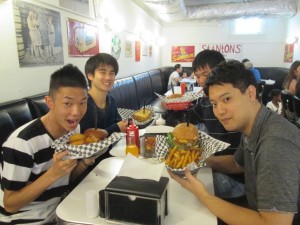
After the long-haul flight from Tokyo to Houston, I caught sight of the vast extent of America from the window of the plane which made me being unable to wait for the coming research internship in U.S. I found a lot of cultural differences between Japan and U.S from the moment I stepped outside of Houston George Bush Intercontinental Airport. I was surprised that bus drivers spoke to me in a friendly way when we were waiting for a shuttle at the airport; that could never happen in Japan especially in my hometown Tokyo. Furthermore, they were interested in what I had to say. When I had breakfast at the hotel on the second day of Houston, a person who was taking him breakfast by himself asked me the reason why I came to U.S and I was caught in cross fire of questions because he showed an interest in my background, country, hometown, university and research. I found myself absorbed in talking with him and joined his table.
I was amazed at the atmosphere of the city and people because they seemed almost the same as American television dramas I watched in Japan! Although I thought all American people use English when they talk with their family, colleague and friends, in Houston I’ve seen some of them speaking in Spanish when they talk with their colleagues and other people use Chinese to communicate with their lab mates at Rice University. That reminded me Prof. Jimbo’s talks in the session on the value and importance of international research experience which let me realize the good points of both Japan and U.S when conducting research. The American custom means that people who has diverse background cooperate with each other when approach research challenges..
The first week in Houston was a meaningful time for me. One of the most helpful lectures was Prof. Kono’s talk about graduate study and academic careers in the U.S He inspired me to pursue the challenge of applying to Ph.D programs in the U.S because I was fascinated by the American merit system in both the academic and business fields. In the U.S, we have equal opportunities to be appointed to positions regardless of our age if we are appropriate person for it. On the other hand, in Japan, wages and promotions are usually in proportion to seniority and sometimes it can discourage employees. His lecture motivated me to build my career in U.S.
On the weekend, the day U.S fellows went back their hometown, I visited the Houston Museum of Natural Science and ate American burger for a lunch with a few U.S and Japanese fellows. In the museum, I was impressed by one of the U.S fellow’s opinion. He showed anger to the explanation of the species extinction which says “The most common reasons for animals going extinct are unsustainable harvest, both of the animals and trees in their habitat, as well as habitat destruction to pave the way for development.” He said “No, it’s because of us.” I deeply agree with him because the explanation looks like another person’s affairs but we humans have caused these situations and it has given rise to species extinctions. I am eager to discuss other various problems around us with persons who has different culture from me.
How did you prepare for your research internship at Rice University before leaving Japan?
I belong to the Takizawa Lab at Waseda University and our lab conducts collaborative research with Prof. Tezduyar’s Lab at Rice University. Prof. Tezduyar is a pioneer of the Fluid and Structural Interaction (FSI) and founder of The Team for Advanced Flow Simulation and Modeling (T*AFSM). Fortunately, my host lab is his laboratory and he is my primary mentor in Rice University. Thus, I have prepared for my research project in Rice University by reading his book “Computational Fluid-Structure Interaction: Methods and Applications”.
Question of the Week
Why someone are raising the Texas flag in their houses and buildings?
- Did you know that Texas used to be its own country prior to becoming a U.S. state? This means that the Texas state flag is the only state flag in the U.S. that also used to be the flag of a country. So people who were born and raised in Texas (or who have lived in Texas a long time) have a lot of ‘state-pride’ as well as being proud of being an American. So you see the Texas flag used in a lot of different ways including on shirts, signs, buildings, homes, etc. Click here for more on Texas history or the Texas state flag. Hawai’i is also unique in that it used to be its own country and was ruled by a monarchy so it is home to the only royal palace in the U.S.
- Other states are also very proud of their unique and local history but typically don’t display their state flag as ubiquitously as in Texas. Rather, in many other states you may find t-shirts or merchandise that displays the geographical shape of the state or the state bird or other icon. So Americans typically have a great deal of local or hometown/home-state pride in addition to national pride.
Week 02: First Week in My Research Lab at Rice
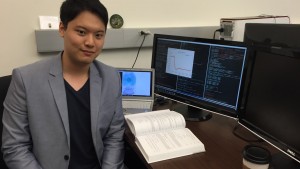 The first day when I visited Rice University, I was amazed at how beautiful Rice’s campus is which made me feel like I was in a Harry Potter film. Although I had previously met Prof. Tezduyar in Tokyo when he visited Waseda University, I was a little nervous on my way to his office since Prof. Tezduyar is the greatest pioneer of the Fluid and Structural Interactions (FSI) and a founder of the Team for Advanced Flow Simulation and Modeling (T*AFSM) . However, once he opened the door with a friendly smile, my nerves calmed down a bit and we livened up the conversation about my research project. Fortunately, he is my primary mentor. It is such an honor to receive advice directory from him! When I stepped into the laboratory, I realized that a lot of talented students from all over the world gather in United States to conduct research. Only one lab mate is American and the others are come from different countries such Turkey and China. This would never be seen at Waseda
The first day when I visited Rice University, I was amazed at how beautiful Rice’s campus is which made me feel like I was in a Harry Potter film. Although I had previously met Prof. Tezduyar in Tokyo when he visited Waseda University, I was a little nervous on my way to his office since Prof. Tezduyar is the greatest pioneer of the Fluid and Structural Interactions (FSI) and a founder of the Team for Advanced Flow Simulation and Modeling (T*AFSM) . However, once he opened the door with a friendly smile, my nerves calmed down a bit and we livened up the conversation about my research project. Fortunately, he is my primary mentor. It is such an honor to receive advice directory from him! When I stepped into the laboratory, I realized that a lot of talented students from all over the world gather in United States to conduct research. Only one lab mate is American and the others are come from different countries such Turkey and China. This would never be seen at Waseda
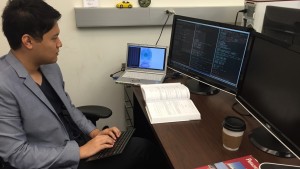
All I can hear is the sounds of typing. We communicate with lab mates by using chats tool. ~ Tatsuya Tanaka
University in Japan where most of the members of laboratory are Japanese. I felt flushed in this research environment and it was sometimes challenging for me to discuss my research using technical terms in English. However, this is what I expected in my internship program. I was already inspired by international research environment.
Master’s Thesis Defense: In the middle of the first week in my research lab, I attended my lab mate’s master thesis defense presentation. It was a good opportunity for me to compere the U.S. style to a master defense at my home university. The day when the master defense presentation was held, I found notices throughout the building. That means everybody who is interested in the topic can join it and ask questions. Whereas presentations last for 12 minutes and the discussion period is 3 minutes per each candidates at my home university, at Rice University he gave a 20 minute presentation and had a discussion for 30 minutes with the committee members. Candidates must answer tortuous questions appropriately. It was just like defending their thesis from judge’s questions and I realized the reason why they call it master “defense”.
Weekend Shopping: With a few Japanese fellows, I went the huge shopping center “Galleria” this weekend and enjoyed shopping, foods and activity. We usually go several cities like Shibuya and Shinjyuku and drop some shops to buy clothes, shoes and bags in Tokyo. In Houston, however, we can buy everything we need in only one place. Furthermore, we can enjoy ice skating and virtual reality games. In the evening, we back to Rice University to join the welcome back party. But the party was almost over still it was 6 pm. It surprised me because I have expected American party lasts until mid-night and many students join it. Perhaps, they are busy preparing for classes.
Question of the Week
Why was the welcome back party over before 6 pm? Is it normal in U.S?
- Perhaps the name of this event was a bit misleading. It was a university-organized welcome back fair for new and returning students to Rice campus and since it was a university organized event it was held during the daytime. It likely had food, free give-aways, and events on the main campus outdoor areas as was busiest during the afternoon. If it had been a student-run/organized party it would more likely have taken place at night and been held in one of the residential dormitories. Student parties can and do go very, very late at night and perhaps you can ask one of the Rice undergraduates you get to know if you could attend any student-organized party that might be held at one of the colleagues while you are here at Rice. A good rule of thumb is that if it is a university-organized event it will probably be held in the day time or early afternoon (since the university employees need to go home to their families at night) but if it is a student run/organized activity it is more likely to take place during lunch time or in the evening/night when students do not have classes scheduled.
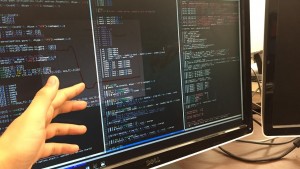
Research Project Overview
I am approaching the flow simulations for drogue parachutes for NASA’s new exploration spacecraft “Orion”. The flow simulations allow us to analyze the complicated phenomenon which cannot be seen directly. Since the space shuttles was abolished because of its extraordinary cost, the parachutes system is adopted when a capsule returns to earth from space and lands on the Mars. But we cannot conduct experimentations in the Mars condition because first, on Mars the gravity and composition of the air is completely different from the Earth and two, it is almost impossible to conduct drop test in an altitude of 35,000 ft where the drogue parachutes is deformed. Thus, I will approach the assessment of parachute’s efficiency and stability performance by applying the Computational fluid dynamics (CFD). CFD solve nonlinear differential equation like the Navier–Stokes equations by calculating again and again in computers because these equation cannot be solved mathematically. In fact, Prof Tezduyar computed Orion’s main parachute which is used for deceleration. And I am computing Orion’s drogue parachute which is used for stabilization.
Week 03: Interview with a U.S. Researcher
I interviewed two lab mates; Aaron and Mei. Two of them have totally different backgrounds and career path. I would like to share their interesting talk.
Aaron
He is second year of master’s student in Rice university pursuing a degree in Mechanical Engineering. Interestingly, he spent four years at the U.S. Air Force Academy where he has studied the mechanical engineering and submitted himself to military training. A few of the most talented students in Air Force Academy get the opportunity to conduct research as master course’s student in renowned universities in U.S including at Rice University, the Massachusetts Institute of Technology and the University of Washington. He was raised in the Republic of Zambia and South Africa before he came to America when he was high school student. He plans to become a helicopter test pilot in the Air Force and contribute to research developments. He decided to conduct research about Computational Fluid Dynamics (CFD) at Rice University because it is a very practical field and we can apply its methods to a wide variety of fields such as material science, bioengineering, civil environment and so on. According to what he said, it is very different to study at the Air Force Academy and to conduct research as a graduate student in terms of both of campus life and the atmosphere of students. At the Air Force Academy, students do not have to conduct research but are required to take a lot of classes and military training. On the other hand, at Rice University, students focus on conducting their research and most of them are planning to go into academic fields in their long term career path.
He said our laboratory is comparatively small because we have seven lab members; two PhD students from Turkey, three master students from china, one visiting doctoral student from Japan and only one American student, Aaron. He says interaction with international people is very important because he is non-international student in U.S In our laboratory, they usually use google chats to communicate with each other. According to our discussion, he agrees that we should not talk about unrelated research but it is important to interact with lab team members.
Question from Aaron: He has curiosity of daily life and family life in Japan.
My Answer: It is totally different from U.S. We do not usually hug each other and say “I love you” frequently.
Mei
Mei just passed his master’s defense a week ago and completed his Master’s degree in mechanical engineering. He started his undergraduate degree in mechanical engineering in China where he spent two years and after that, he has conducted research about Computational Fluid Dynamics (CFD) at the University of Birmingham in UK. He chose mechanical engineering as his major because his parents are both automobile engineers and he was influenced by them. After he completed his bachelor’s degree, he decided to continue to research about CFD since his supervisor in University of Birmingham specializes in CFD especially the computation analysis of aorta. According to his talk, compared with universities in the UK and China, Rice University is much smaller in terms of the numbers of professors and students. Furthermore, during his undergraduate program he visited the U.S twice, and he saw the energy and diversity of the students at US universities. It is one of the reasons why he left UK and applied to master’s course in the U.S. He also mentioned how it is different between universities in China and the U.S to conduct research. He said many undergraduate students at Rice University communicate and work with professors, but undergrads in China usually do not have enough opportunities and the inspiration to develop their research skills and insights. Graduate students in China also need more support in funding and guidance for their research. Overall, he thinks students in Chinese universities need more resources to support them for a good development in research. He was inspired by both Dr. Espino at the University of Birmingham and Dr. Tezduyar at Rice University because they gave him great advice and encouragement in terms of conducting research. He said he has also received great help and learned a lot from Dr. Takizawa in Waseda University during his research visits at Rice University. Now, he is planning to proceed to the PhD program to continue to research. Wonderfully, my home university, Waseda is one of his options!
Question from Mei: How do you handle things when you have a difficulty in research?
My Answer: At first, I read relevant thesis and try some solutions. When I cannot solve it by myself, I ask PhD student or professor and discuss solutions.
Reflections on the Interviews
At first, it made me a little nervous to interview my lab mates because it was the first time to sit there and discuss with them. But the moment when we started the interview, I was absorbed in talking with them. This interview is meaningful opportunity for me not only because they let me get to know about their background and opinions on research but also because they provided me with useful information to proceed to PhD programs in the U.S. Furthermore, we all realized how it is important it is to discuss with our lab mates through this interview. Actually, we have quite a few discussions in our lab and usually use Google chats to communicate with each other. However, in the wake of this interview, we started weekly meetings to discuss research to know lab mates and share solution when someone face difficulties.
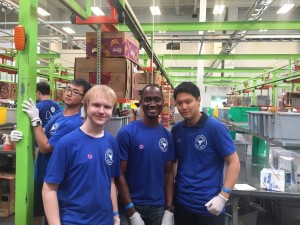
Weekend: I joined a volunteer activity in Rice Center for Civic Leadership’s Outreach Day. In this program, I choose to work as a volunteer at the Houston Foodbank which is Houston’s largest food donation foundation. This Food Donation Center and Food Pantry gives aid to Houston’s hungry, homeless, unemployed and all others in need of food assistance through food drives. We sorted goods donated by food companies and drink manufacturers. I was moved when I saw a lot of families positively participate in the volunteer activity and schoolchildren carrying heavy boxes in real earnest. It made me realize that the culture of contribution to society is rooted in U.S.
Question of the Week
In Japan, people works as volunteer when catastrophes such as earthquake happened but they tends to save their money and not to daily contribute to society. Why American and European people incline to contribute to society in daily life?
- The idea of ‘giving back to your community’ is very ingrained in American society and culture and it is common for people to volunteer regularly through their schools, community organizations, local non-profits, and/or their religious groups. In fact, it is so common a part of American culture that U.S. students are often surprised that volunteering is not as common in some other countries. For more on volunteerism in the U.S. you may want to read some of these resources or do further research on your own.
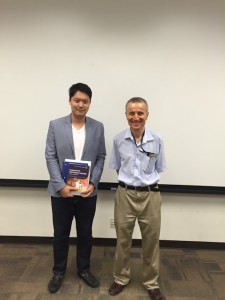
Research Project Update
Thanks to the supercomputer “DAVinCI” at Rice University and great advice from my lab mates, my research has made progress. Currently, I am approaching fluid and structural analysis to acquire the initial conditions of FSI. It is required for approaching FSI to compute accurate shape of parachutes and flow distribution. Thus, I apply pressure difference distribution which I got by fluid analysis to initial condition of structural analysis. And I need to apply the result of structural analysis to flow analysis. I will repeat this cycle to acquire more accurate results of computation. When Dr. Tedzuyar computed the main parachute of Orion which is used for deceleration after drogue parachute was used for stabilization, he reiterated it more than ten times. Computing drogue parachute is more challenging than main parachute because main parachute is inflated in incompressible regime: Mach number is under 0.3, however drogue parachute is used in compressible regime: Mach number is over 0.3. Therefore, we need take into account of density variation which means energy balance equations must be added in governing equations.
Fortunately, I have also had the opportunity to attend two Dr. Tezduyar’s classes “Fluid Dynamics” and “Computational Fluid Dynamics”. These classes impressed me because the professor tried to explain simply with good examples and attract student’s interests in its field and in fact, the lecture is very easy to understand and interesting! Furthermore, the professor communicated with students during classes. On the contrary, in Japan, most of classes is very defensive style. We have a quite a few talks with Prof. Tezduyar during his classes. I wish I could continue taking his classes in whole this semester.
Week 04: Reflections on English Language & Life in the U.S.
Thanks to all of my experiences in the U.S, my English skills, especially using technical terms, has greatly improved. The first time that I attended Dr. Tezduyar’s classes, all I could do was just catch what he said because a lot of technical terms were used in the class which I am not used to hearing. However, after joining his class and having discussion about our research in my laboratory, I came to able to guess the meaning of technical words from the context and could answer my professor’s question. His classes often impressed me both in terms of course content and the interactive natures of the class because it makes me think carefully about why these equations are true and what they mean. Contrary to the system in Japan, where most of the classes are not interactive for students, in the U.S, professor and students teach and learn together. While I will spend a short time in the U.S, through attending Prof. Tezduyar’s class I realized that I have been thinking more about the meaning of equations he used in English during his classes.
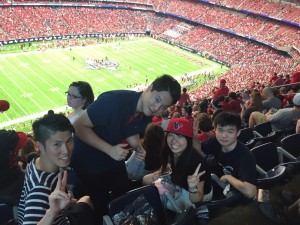
In my daily life in the U.S, I found interesting cultural differences. American people tend to appreciate someone’s kindness. On the contrary, Japanese people are inclined to respect others and apologize for their behavior even if they are not rude. When I attempted to open the door and walk in the laboratory, one of my lab mates also tried to leave room and he let me enter first. Since I felt sorry about disturbing him and was grateful feeling for his kindness, I said “Sorry, Thank you”. But it was sound werird to him that I said “Sorry”. In the U.S, people usually just say “Thank you” but do not say “sorry” at the same time. It made me reflect on my country, Japan, objectively and realize that language can reveal its nature and culture. To respect each culture is one of the most important tips to conduct research in the U.S where various people are gathering.
I have learned English by watching English drama and films such like “Breaking Bad”, “Star Wars” and so on. In Japan, we start studying English when we are in primary school but usually classes focus on the grammar and reading articles. Therefore I needed to improve my speaking, listening and writing skills in English after graduating high school. However, it was a little bit difficult for me to improve them by myself because I did not have the opportunity to practice speaking English in Japan. Thus, I spent most of my summer and spring vacations overseas and made many friends. They provideed me with practical feedback and helped me to improve my speaking skills. Furthermore, movies and dramas are very helpful to learn how native English speaker separate phrases, the context, and to see English in the common and business situations. I have watched my favorite movies repeatedly and memorized words.
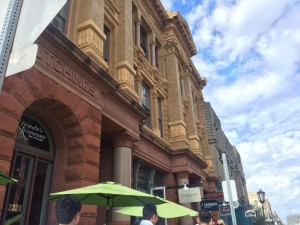
This weekend, I attended the football game between the University of Houston and The University of Oklahoma in NRG Stadium. The stadium was full of people and energy. I could not believe it was not professional league but a college, amateur league. After the game, we were invited to Prof. Shimizu’s house for a party. She is a professor at Rice who specializes in history and we got to enjoy such nice home-made dishes that she prepared. Especially the mapo tofu (麻婆豆腐) was exquisite. I was amazed she learned how to cook from professional chef who had made dishes for Chiang Kai-shek (蒋介石) in Taiwan. Also I went to Galveston Island with a few Japanese fellows and Chinese friends from Rice University. We enjoyed seafood dishes, beach and the traditional atmosphere. I am glad that my Chinese friend loves Japanese culture; music, anime and manga. He even played Japanese songs in the car and we have talked about interesting aspects of the history and culture of both of Japan and China.
Question of the Week
Why Imperial customary measurement systems is still used in the U.S even when we talk about research? In other countries including Japan, we use the International System of Units and most paper written in English also adopt it. Sometime it is confusing to figure the amount in the U.S.
- Yes, one of the most surprising and confusing things for Americans traveling abroad is the realization that they can’t tell the weather/temperature because we are the only developed country in the world that still uses the the Imperial System, including Fahrenheit, instead of the metric system. The National Institute of Standards and Measures (NIST) has a nice Capsule History of the United States and the Metric System that might be interesting to read. You can also find many articles on this topic if you ask Google Sensei this same question.
Research Project Update
Contrary to numerical analysis in incompressible regime, when we approach to compressible flow, we take into account the change in density. Thus, the energy balance equation should be added to governing equations because the value of unknown quantity is increased. In high Reynolds number conditions, calculation was stopped because of negative value which has been never seen when I approached incompressible calculation. To determine the cause, I am writing a program which calculates the minimum values of unknown and I found that the temperature turned into negative value. Currently, I am working to fix that error and continue calculations.
Week 05: Research in the U.S. vs. Research in Japan
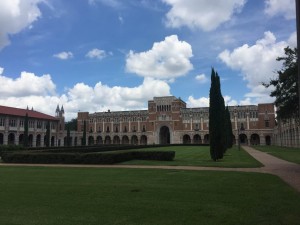
Fortunately, I have started conducting research since this April when I became a senior student at Waseda Univesrsity and have now had the great opportunity to conduct research in the United States this summer too. My time in the Tezduyar Lab helps me understand both the differences and similarities in terms of communication and research style between the U.S and Japan.
One of the differences is the attitude towards research and learning. Students in the U.S are much more independent and active on their projects than in Japan and take initiative and work hard. They never wait for instructions from supervisors or senior students and try to solve problems by themselves by reading books or papers. At the beginning of this semester, two new members joined the Tezduyar Lab; one of them is a PhD student from Turkey and the other is masters student from China. Though they have background knowledge about our field and learned research methods in their home university before coming to Rice University, there was not an introduction seminar or lecture in the Tezduyar Lab to help show them how to use equipment and how should they approach their project. Thus, it is required for all of students to think for themselves and then act. That seems contrary to Japan. Although the Takizawa Lab that I belong to at Waseda University, if anything, has a more American nature, most of students in Japan work with their senior student and tend to rely on them. Also senior students have more responsibility for looking after undergraduate students or young graduate students in the laboratory. This is undoubtedly helpful for new members to understand how to conduct research and use the applications however, sometime it gives rise to problems in Japanese society. There is a vague phrase in Japan: “People who are waiting for instruction”. Especially in a company, it is said that new employees are useless because they are inclined not to take action by themselves unless their boss give specific instruction to them. This research internship in the U.S has helped me develop a sense of crisis and realize that we should break this situation to compete in the international society. In order to achieve it, we will be required to not only have language skills but also practical experiences and the knowledge to explain our own culture and accept other natures in the community of nations.
The other differences I found is the way we communicate with professors. I often saw my lab mate disagreeing with my professor’s opinion and suggesting their alternative idea. This seldom happens in Japan because we usually think it is a little bit rude and we are afraid of their hating us. Even when students have a different opinion from Prof. Tezduyar, he accepted student’s view, asked their reason, discussed further and then reached a satisfactory solution. Also I saw the similarity in terms of communication. In both Japan and the U.S, students have a conversation with professors respectfully. Although, on the contrary to Japanese, English has a few honorific terms, they still show professor respect. I realized it is totally different to speak friendly and to talk without respect. We should not be rude because English has a few honorific expressions.
Question of the Week
I often see equipment such like computer, display and lab ware, seem to be old in Rice University. In the U.S, where universities or laboratory most invest money? Hiring talented faculties and post doc, purchasing equipment, constructing building?
- This is largely due to the difference in how research is funded in the U.S. vs. Japan. In the U.S., profesors must get research grants to be able to fund not only the equipment/computer/lab supplies but those research grants must also pay for student stipends and tuition for their graduate students. This mean that the majority of all research grants received go to fund PhD students, not to equipment and materials/supplies. In comparision, in Japan Master’s and PhD students typically pay tuition individually and they are not commonly paid a stipend for working in the lab. This means that in Japan most of the money that professors receive for research grants can be spent on equipment, computers, facilities and materials and supplies. So this is partially due a structural difference in how research is funded in each country. For more on this see the Funding of Research in the U.S. and Japan section on the Research in the U.S. Resources page.
Research Project Update
I spent almost all of this week preparing for the poster presentation by organizing my analyzed data, making graphs and figures, designing the poster and so on. Because we compute by subdividing analysis domain when we approach fluid mechanics analysis, I got more than 5 million data in just one step. I computed it about ten thousand steps and analyzed three conditions during this internship. Thus, totally, I have fifteen billion data only in fluid computation. In addition, I analyzed structural mechanics. It is sometimes hard to arrange how to show the results, but it is also one of the best part of computational analysis to teach the huge amount of data.
Week 06: Final Week at Rice & Research Poster Presentation
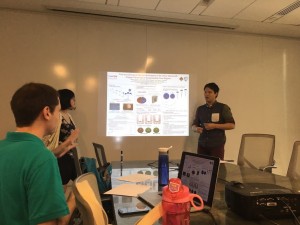
My wonderful time has gone by so fast conducting research in Rice University and I have received valuable inspiration for my long-term professional career path from the faculty, lab mates and students that I met during the Nakatani RIES internship. It has given me the courage to challenge an go on graduate school in the U.S. There are several factor which made me decide.
First, my concerns over the challenges of attending graduate school in the U.S were dispelled through this internship. Before I participated, I was worried about going a different way from what most Japanese students follow even though I had the desire to pursue my own unique path overseas. In Japan, people usually move on a fixed course in their career. High school students desperately study in order to pass entrance examination of famous university no matter whether they have specific interest in the field and they do not have a definite objective for their long-term career. Yet, more than 80% of high school students go on to university or college. Furthermore, parents invest huge money in education for they are also eager to have their children enter famous colleges. In the last year of university, Japanese students start job hunting, all at the same time hoping to get a job offer from well-known large enterprises based on the idea that a jobt at a major corporation will lead to a peaceful life. When I ask them why they prefer these careers, they answer “Because everybody else does that”. They go on their path as if they walk along the same railway. I always felt something was wrong with this situation however, I could not decide to walk a
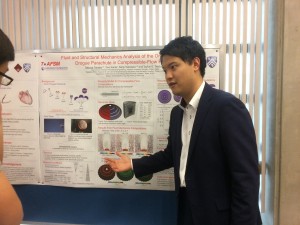
different path. My experience this summer encouraged me to walk on my own path. The people who I met at Rice University looks glowing and enjoying their work. I genuinely look up to Japanese professors and any other Japanese people who are working in the U.S.
Secondly, I found that I prefer the U.S research style. I realized that both individual work and teamwork is treated as important in terms of conducting research projects in the U.S and they often hold lively discussions. When I needed to rehearse for my poster presentation, we had a detailed discussion about wording and what I mentioned on the poster, why my research is challenging and how I got my results. Even when they talk with a professor or senior students, they often disagree in their opinions and U.S. professor will also accept their different opinions. In addition, when I presented my research at the poster session, I was amazed that people in the U.S showed an interested my research subject no matter whether it is their field of speciality or not. Through talking with researchers in other fields, I made a new findings which helped me to improve my research. There is valuable environment for researchers to devote themselves to research work and study in the U.S. It fascinated me and strength my intention to go on U.S graduate school.
Talk of Nobel Prize Winner
I participated in an talk given by the Nobel Prize winner, Woodrow W. Clark II which was held by Rice University’s Baker Institute for Public Policy. This event is about Smart Green Cities (watch video) that have been proposed as a promising strategy to provide and support basic integrated infrastructures. Dr. Clark focued on the economics for smart green communities. His current work is very attractive and combines public policy, science and technology, economics and finance methods to generate responses to climate change from governments and businesses. These kind of talks are often held at Rice University and surprisingly, most of the time the cost is free!
Question of the Week
Traditionally in Japan, students frequently job-hunt and are hired en masse after graduating from university, which called simultaneous recruiting of new graduates. I wonder what is majority path of graduate student after Ph.D or master and how do they find job in the U.S.
- This is an excellent question. See the Careers in STEM section on our Research in the U.S. resources page for more information
Final Research Project Update
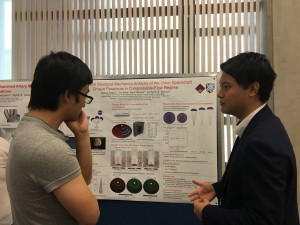
Research Host Lab: Tezduyar Lab, Mechanical Engineering, Rice University
![]() Research Project Poster: “Fluid and Structural Mechanics Analysis of the Orion Spacecraft Drogue Parachute in Compressible-Flow Regime”
Research Project Poster: “Fluid and Structural Mechanics Analysis of the Orion Spacecraft Drogue Parachute in Compressible-Flow Regime”
Drogue Parachute in Compressible-Flow Regime. My host lab is Tezduyar Lab and wonderfully, my primary mentor is Prof. Tezduyar who is pioneer of Fluid—Structure Interaction (FSI). In 2011, space shuttle has retired because of huge cost. Nowadays, NASA is developing Orion spacecraft as alternative vehicle to carry 4 crew to space, moon and mars. Orion come back to the earth by parachute to stabilize and reduce speed. For stabilize capsule, two drogue parachutes are deformed in compressible-flow regime which mean Mach number of flow velocity is more than 0.3. After detached from capsule, there main parachute is used for deceleration in incompressible-flow regime. Our research group the Team for Advanced Flow Simulation and Modeling (T*AFSM) has already analyzed main parachute before. Thus, I focus on drogue parachute which is more little bit challenging because it is opened in compressible flow which mean we need take into account of density variation. There are problems to evaluate parachute performance in field tests. A drop test which drop parachute from aircraft costs more than a million dollar for each test and maximum altitude is limited. Also, parachute has 23 ft diameter and about 100 ft height which is too large to fit it in a wind-tunnel and we have Scaling challenge due to coupling between the canopy deformation and the airflow. Therefore, computational analysis is helpful tool to evaluate parachute more detail and low cost.
Analyze parachute is challenging in terms of computation because airflow easily change shape of parachute and if shape of parachute is changed, air flow is also changed. So, flow and structure is interactive each other. A technique to take it into account if called FSI. FSI computation has a lot of difficulty and calculation easily unstable. Thus, we need acquire more accurate shape of parachute as starting condition of FSI. My research objective in this summer is to obtain in.
We use Compressible Navier–Stokes equations as governing equations and Compressible-flow SUPG method as discretization and stabilization Technique. We analyze three condition; Mach number is 0.3, 0.5, 0.7, where altitude is 35,000 ft. Because of calculate cost, we model how much air pass across parachute. To acquire pressure distribution on parachute, I conducted flow mechanics computation. I apply the result of it to structural mechanics computation as starting condition to deform parachute. And I obtain the shape of parachute and Method for calculating the FSI starting condition. As future direction, I will apply this result to FSI computation and in long-term objective, we help parachute engineers to evaluate and improve parachute performances.
Week 07: Visit to Washington, DC & New York City
Coming Soon!
Final Report: Reflections on the Nakatani RIES Fellowship
I have learned many valuable things from participating in the Nakatani RIES Fellowship program. It has varied my view of potential careers and my attitude towards research and study. There are several important things which caused these changes.
One of them is the virtuous cycle of U.S universities. In the U.S, universities make an investment in hiring talented researchers to enhance the quality of research. Improving the quality of research activity and education leads to a growth in the popularity of the university and the number of applications from brilliant students. By producing excellent alumni to both academia and industry, universities receive donations from them. And they use these funds to encourage investment in human resources. I was able to feel that this good cycle is working effectively through spending time at Rice University. Based on this nature of U.S universities, students are mutually lab mates and good rivals. Therefore, graduate students in the U.S have more responsibility for their research than in Japan. If they neglect their studies, they could not stay at the university. In my point of view, this is one of reason why students in the U.S ambitiously tackle studying and research. It sounds harsh but we need be a real go-getter to be active in the international community.
The other thing that has inspired me during this program is getting to know Japanese people who have succeeded in the U.S. This program gave me a great opportunity to meet faculty at U.S universities like Prf. Kono and Prof. Shimizu at Rice University and Prof Uemura at Columbia University. They shared with me about what research life and specific academic career paths are like in the U.S. and this encouraged me to decide go on graduate school in the United States. In addition, people who are not in academic fields also impressed me like Mr. Koizumi who is working for Office of Science and Technology Policy at the White House. I was so glad to see that Japanese American could engage in U.S government. Next time, I would like to inspire students who come from Japan.
This program varied my view of career paths. Before participating in it, I had some worries about going on to U.S society in future though I had the desire to pursue my own unique path overseas. In Japan, people usually go on their path as if they walk in the same railway. I always feel something wrong with this situation however, I could not decide to walk different railway because it is a little bit challenging to follow different way which most of Japanese student go on. However, through practical experiences in the U.S during this summer, my mind was clear and I would like to concentrate on studying more than ever before.
If somebody is interested in the Nakatani RIES Fellowship, I want to say “Be full of fighting spirit and taking a positive part in any activity”. This program will give you great opportunities however, it’s all up to you whether make or break this chance.
Finally, I would like to express my deep appreciation for each person who prepared and managed Nakatani RIES Fellowship Program 2016.
Final Question
What is one of the most important policy of U.S education system?
- There are many policies regarding education in the U.S, particularly at the K-12 level, that are set by the Department of Education but states and local school boards have great power in setting educational curriculum in the U.S. since we do not have a nationalized education system like in Japan. For more on the U.S. education system click here. At the university level, most of the policies regarding education in the U.S. are tied to funding for higher education either through federal student loans issued directly to students (used to pay tuition and fees to the universities) or through funding available for research through federal agencies. If you want to read more about educational policy in the U.S., particularly how it impacts STEM, you might want to look over some of these resources or consult Google sensei about this question.
- White House Office of Science & Technology Policy: Improving STEM Education
- Department of Education: Science Technology, Engineering and Math: Education for Global Leadership
- American Chemical Society: Science Education Policy
- Rice Baker Institute: Science & Math Education
- Baker Institute: Civic Scientist Lectures
